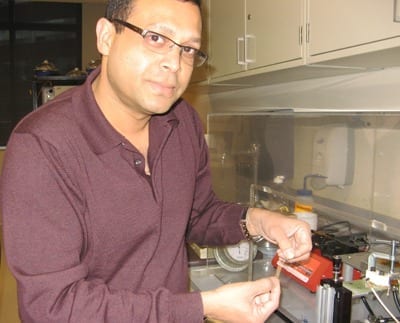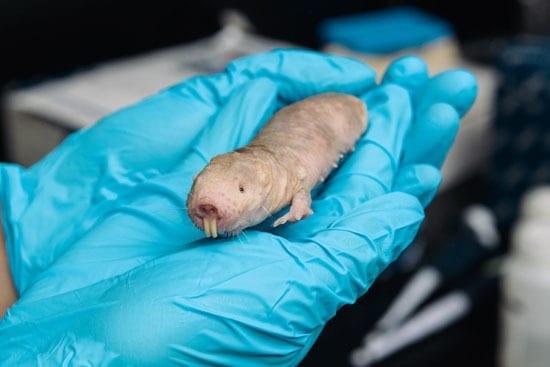
Think about windows coated with transparent film that absorbs harmful ultraviolet sunrays and uses them to generate electricity.
Consider a water filtration membrane that blocks viruses and other microorganisms from water, or an electric car battery that incorporates a coating to give it extra long life between charges.
The self-assembled copolymer block film that makes it all possible is now being fabricated with intricately organized nanostructures, giving them multiple functions and flexibility on a macroscale level never before seen.
Gurpreet Singh, a Ph.D. candidate in The University of Akron College of Polymer Science and Polymer Engineering, led a team of researchers to devise a method that enables the films to assemble themselves and allows them to serve as templates or directly as end products. The films can be embedded with nanoparticles that enable everything from data storage to water purification.
Breakthrough with many functions
Superimposed with nanopatterns that allow them to be implanted with a variety of functions — electronic, thermal or chemical — the films can be produced at an industrial level, which is no small feat in the world of science, says research team member Alamgir Karim, associate dean of research for the college and Goodyear Chair Professor of Polymer Engineering. Other research collaborators include Kevin Yager of Brookhaven National Laboratory in Upton, N.Y., Brian Berry of the University of Arkansas and Ho-Cheol Kim of the IBM Research Division of Almaden Research Center in San Jose, Calif.
“We have moved films manufacturing from microns to meter scale, opening pathways from the lab to fabrication,” Karim says. “Fundamentally, it allows us to practice nanoscience on a large scale. We can now produce these films quickly and inexpensively, yet with precision and without compromising quality.”
Created with speed and uniformity, compatible with flexible surfaces, and subjected to temperature extremes, the copolymer thin films — developed at the National Polymer Innovation Center at UA — are noted in two recent American Chemical Society Nano journal articles: “Dynamic Thermal Field-Induced Gradient Soft-Shear for Highly Oriented Block Copolymer Thin Films“and “Large-Scale Roll-to-Roll Fabrication of Vertically Oriented Block Copolymer Thin Films.”
Market-ready technology
Funded by the National Science Foundation, the research represents a market-ready revival of a technology developed by Bell Laboratories in the 1950s for metal and semiconductor purification and adapted in the 1980s for polymer crystallization. Since then, the technology remained dormant, until now.
The Latest Bing News on:
Self-assembling films
- 32 must-see low budget movieson May 1, 2024 at 10:51 am
Some of the biggest movies in the world have been made with blank checks ... Land (albeit in controversial fashion), but that doesn’t take away from its humble assembly. Shot on a budget of ...
- 'Shaking It Up': View Texas icon Liz Carpenter up close and personal in new documentaryon April 30, 2024 at 9:41 am
That's a part of what we see and hear thanks the new 77-minute documentary, "Shaking It Up: The Life & Times of Liz Carpenter," co-produced and co-directed by her daughter, Christy Carpenter, along ...
- Pretty Ugly People Streaming: Watch & Stream Online via Peacock & Amazon Prime Videoon April 29, 2024 at 2:37 am
Tate Taylor’s heartwarming black comedy, Pretty Ugly People is a compelling package of friendship, sorrow, human failures, and self-discovery. The movie does a remarkable job of exploring these themes ...
- Alien Movies, Rankedon April 26, 2024 at 10:00 am
There are whole eras of Alien at this point. The first few movies, once collected in a nifty, nine-disc DVD box set called the “Alien Quadrilogy,” all star Sigourney Weaver as Ellen Ripley, an ...
- Movies in North Texas theaters on April 26 and coming soonon April 25, 2024 at 3:00 pm
UNSUNG HERO This faith-based drama tells the story of the real-life Smallbone family, who moved from Australia to Nashville, Tenn., to pursue musical careers. Starring Daisy Betts, Joel Smallbone, ...
- 40 Films to See This Summeron April 25, 2024 at 8:52 am
The summer season is upon us and, per each year, we’ve dug beyond studio offerings to present an in-depth look at what should be on your radar. From festival winners of the past year to selections ...
- Max May 2024 Movies, TV Shows, and Sportson April 24, 2024 at 4:26 pm
Discovery has announced the movies, TV shows, and live sports that will be available on the Max streaming service in May. The Max May 2024 lineup includes season three of the comedy series Hacks, the ...
- How Films Like ‘Civil War’ Can Spark Important Conversations and Help Defeat the ‘Outrage Industrial Complex’ (Guest Column)on April 23, 2024 at 12:17 pm
It was only a matter of time until a movie like "Civil War" portrayed the devastating potential of our toxic political culture, writes Steven Olikara.
- Candida Royalle’s Fight to Fuse Feminism and Porn Movieson April 20, 2024 at 8:19 pm
Illustration by Elizabeth Brockway/The Daily Beast“Each time I know I have to go on stage soon I feel like screaming and crying,” Candice Vadala wrote in her journal in November 1980. It was Election ...
- MIT Technology Reviewon April 17, 2024 at 3:00 am
Chip companies from the US and China are developing new materials to reduce reliance on a Japanese monopoly. It won’t be easy.
The Latest Google Headlines on:
Self-assembling films
[google_news title=”” keyword=”self-assembling films” num_posts=”10″ blurb_length=”0″ show_thumb=”left”]
The Latest Bing News on:
Self-assembling nanoparticle films
- New class of spongy materials can self-assemble into precisely controllable structureson April 30, 2024 at 8:02 am
A team of researchers led by the University of Massachusetts Amherst has drawn inspiration from a wide variety of natural geometric motifs—including those of 12-sided dice and potato chips—in order to ...
- Scientists learn from caterpillars how to create self-assembling capsules for drug deliveryon April 26, 2024 at 8:00 am
Self-assembling molecules that spontaneously organize themselves to form complex structures are common in nature. For example, the tough outer layer of insects, called the cuticle, is rich in proteins ...
The Latest Google Headlines on:
Self-assembling nanoparticle films
[google_news title=”” keyword=”self-assembling nanoparticle films” num_posts=”10″ blurb_length=”0″ show_thumb=”left”]











